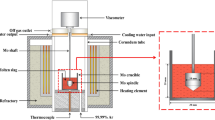Results of calculating the viscosity of acid slags according to the most well-known models used in steelmaking plants for slags with high basicity are analyzed. It is found that with an error of 10%, the calculations of viscosity according to the Urbain model coincide most fully with known data from the slag atlas in relation to acid slags typical for processing spent ceramic-based automotive catalysts. Within the composition of the active coating based on platinum group metals applied to ceramic unit of an automobile catalyst there is extensive use of lanthanide metals, their oxides, and salts that improve product quality characteristics. Cerium oxide is used advantageously, and an increase in concentration of this oxide is confirmed by chemical analysis of a ground mixture of spent automobile catalytic converters supplied for recycling. However, none of the models take account the effect of cerium oxide on melt viscosity. A requirement for taking this into account gives rise to the importance of the task in question. In order to determine this effect, charge composition was calculated to obtain viscosity of 2 poise typical for the technique employed, a charge was melted in a 1 MW DC arc furnace, and melt viscosity was determined by an inclined trough method. Melt temperatures were measured when the viscosity was the same as in the previous experiment. As a result of these studies the effect of cerium oxide concentration on temperature at which values of similar viscosity are achieved is determined. The value of the previously unknown coefficient of the effect of CeO2 on acid slag viscosity (equal to 2.24) is obtained, when it is considered as a network modifier in an Urbain model.





Similar content being viewed by others
References
K. A. Elizarov, M. M. Krutyanskii, I. S. Nekhamin, and S. M. Nekhamin, “New trends in the development of DC arc furnaces,” Russian Metallurgy (Metally), 2014, No. 6, 443–448 (2014).
A. S. Kirichenko, A. N. Seregin, and A. I. Volkov, “Developing a technology for recycling automotive exhaust-gas catalysts,” Metallurgist, 58, No. 3–4, 250–255 (2014).
A. V. Aleksakhin and A. S. Kirichenko, “Automobile catalyzers – a basic reserve of domestic and world production of secondary metals, i.e., platinoids,” Ékonom. Prom., No. 4, 3–7 (2013).
G. Urbain, “Viscosity estimation of slag,” Steel Research, 58, No. 3, 111–116 (1987).
A. Kondratiev, B. Zhao, S. Raghunath, P. C. Hayes, and E. Jak, “New tools for viscosity measurement and modelling of fully liquid and partly crystallised slags,” Proceedings of EMC, 2 (2007).
A. Kondratiev, P. C. Hayes, and E. Jak, ISIJ International, 46, No. 3, 359–367, 368–374, 375–384 (2006).
Q. A. Shu, “Viscosity estimation model for molten slags in Al2O3–CaO–MgO–SiO2 system,” Steel Research International, 80, No. 2, 107–113 (2009).
P. V. Riboud, Y. Roux, L-D. Lucas, and H. Gaye, “Improvement of continuous casting powders,” Fachberichte Huttenpraxis Metallweiterverarbeitung, 19, 859–869 (1981).
T. Iida, H. Sakai, Y. Kita, and K. Shigeno, “An equation for accurate prediction of the viscosities of blast furnace type slags from chemical composition,” ISIJ International, 40, S110–S114 (2000).
T. A. Iida, “Model for accurate viscosity predictions of various types of molten slags and glasses,” in: Proceedings of the Mills Symp., London (2002), pp. 101–110..
K. C. Mills, L. Yuan, and R. T. Jones, “Estimating the physical properties of slags,” J. of the Southern African Institute of Mining and Metallurgy, 111, 649– 658 (2011).
Slag Atlas. Handbook [Translated from German], Metallurgiya, Moscow (1985).
A. G. Chizhikov, P. I. Chernousov, and I. I. Chizhikova, “RF ferrous metallurgy enterprise raw material security,” Vtorichnye Metally, No. 5, 32 (2010).
L. I. Leont’ev and V. G. Dyubanov, “Technogenic waste of ferrous and nonferrous metallurgy and environmental problems,” Ékol. Prom. Rossii, No. 4, 32–35 (2011).
Author information
Authors and Affiliations
Corresponding author
Additional information
Translated from Metallurg, Vol. 64, No. 5, pp. 52–55, June, 2020.
Rights and permissions
About this article
Cite this article
Kirichenko, A.S., Nekhamin, S.M. Effect of Cerium Oxide on Acid Slag Viscosity. Metallurgist 64, 548–552 (2020). https://doi.org/10.1007/s11015-020-01026-4
Received:
Published:
Issue Date:
DOI: https://doi.org/10.1007/s11015-020-01026-4




